Last updated: August 10, 2021
Article
Monitoring Amphibians at Mount Rainier National Park, 2019 Summary
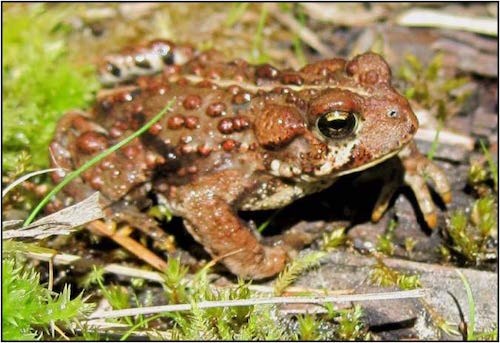
Introduction
Mount Rainier National Park encompasses 236,381 acres of land in Washington State and includes a wide range of ecosystems. There are approximately 385 lakes and more than 400 streams in the park, and these aquatic ecosystems provide crucial habitats to many amphibian species. Most amphibians spend a portion of their lives in aquatic habitats, and they can be greatly impacted by changing environmental conditions. Therefore, monitoring amphibian species abundance can indicate water quality and overall ecosystem health.
Fourteen species of amphibians are known to occur in the park including nine species of salamanders and five species of frogs/toads. One species of particular interest is the western toad (Anaxyrus boreas), currently considered a candidate species for listing by Washington State. The Southern Rocky Mountain population known as the boreal toad (Anaxyrus boreas boreas) is under review for listing under the federal Endangered Species Act. At Mount Rainier National Park the western toad is considered one of the least common amphibians in the park.
What are we doing?
With the help of citizen science volunteers, we monitor amphibian abundance throughout Mount Rainier National Park, concentrating our efforts at sites where western toads are known to occur. We document the phenology of western toads from the onset of egg deposition to metamorphosis and note changes in ephemeral breeding habitats. Our project volunteers also monitor amphibian mortality at select lakes, conduct night surveys, and survey for larval dragonflies.
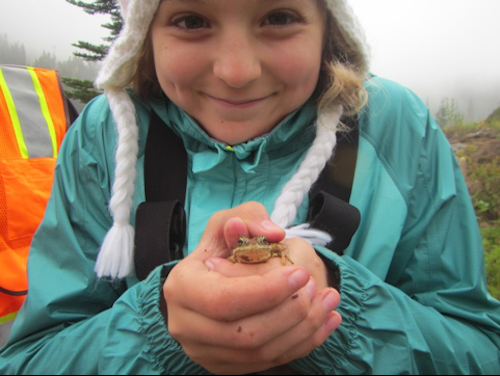
Monitoring Objectives
- Engage volunteers in park science through active participation in field data collection.
- Monitor amphibian populations throughout the park, with an emphasis on the western toad.
- Provide data to the National Park Service management team on the status of aquatic environments and dependent species with Mount Rainier National Park.

Monitoring Methods
- Surveys occur from early July to early September.
- We are using a survey method called a Visual Encounter Survey (VES) to monitor relative amphibian species abundance.
- At Western Toad breeding sites we document specific life stage and size of larval toads (tadpoles), making repeat visits to some sites over the course of the season.
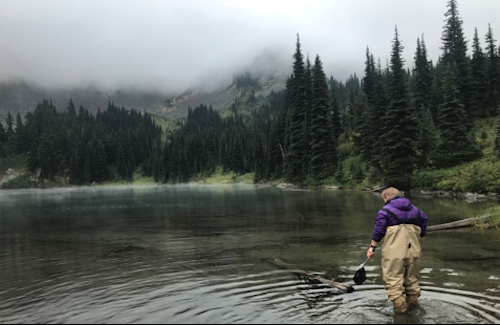
Results: Volunteer Involvement
Since the establishment of this citizen science program in 2009, over 300 volunteers have participated in the project. Volunteers represent a wide range of ages, backgrounds, and experience levels with both data collection and the outdoors. While day-hiking and backpacking on extended trips, volunteers have observed thousands of amphibians, as well as monitored larval toad development at several sites. Volunteers have also contributed to our knowledge of mercury in the park’s lakes and wetlands by collecting dragonfly larvae samples for the nationwide Dragonfly Mercury Project. As of 2019, volunteers have contributed over 5000 hours to amphibian surveys.
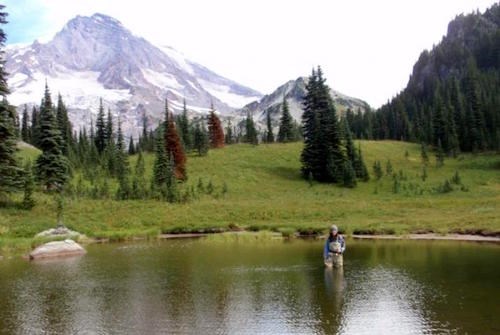
Results: Amphibians
Volunteers have documented 8 species of amphibians (3 salamanders and 5 frogs) at 113 sites since 2009. During the 2019 season volunteers surveyed 28 sites (figure 6), including 5 known toad breeding locations. Highlights this season included observations of 1 and 2 year old juvenile toads in the Three Lakes area, as well as the rediscovery of toad larvae at Lower Palisades Lake. Preliminary results from data collected at 3 toad breeding sites indicate different rates of larval growth, suggesting environmental factors – such as seasonal wetland drying – may impact larval development and metamorphosis timing.
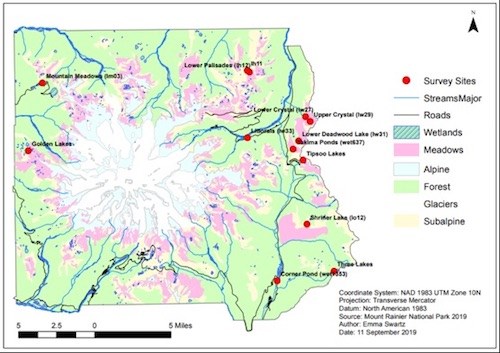
2019 Accomplishments
- Completed surveys at 28 sites throughout Mount Rainier (Figure 6)
- Monitored western toad larval development at 3 active breeding sites
- Observed toad populations at 5 different park locations
- Documented changes in ephemeral amphibian breeding habitat
- Monitored northwestern salamander mortalities
- Collected dragonfly larvae at 3 sites for the Dragonfly Mercury Project
Dragonfly Mercury Project Research Results
Eagles-Smith, C. A., et al. "A National-Scale Assessment of Mercury Bioaccumulation in United States National Parks Using Dragonfly Larvae As Biosentinels through a Citizen-Science Framework" 2020. Environmental Science & Technology.
Interested in Helping?
Each summer from July through September we need volunteers to help conduct our surveys. The Citizen Science program gives volunteers of all ages the opportunity to hike and explore some of Mount Rainier’s lakes and wetland habitats while gaining experience in surveying and science. Previous experience is not needed and surveying equipment will be provided. Free camping is available for volunteers at park campgrounds.
